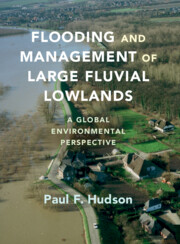Book contents
- Flooding and Management of Large Fluvial Lowlands
- Flooding and Management of Large Fluvial Lowlands
- Copyright page
- Dedication
- Contents
- Figures
- Tables
- Preface and Acknowledgments
- 1 Fluvial Lowlands and the Environment
- 2 Rivers and Landscapes
- 3 Hydrologic and Geomorphic Processes in Fluvial Lowlands and Deltas
- 4 Dams, Rivers, and the Environment
- 5 Hydraulic Engineering for Channel Stability and Flood Control
- 6 Dikes and Floodplains
- 7 Flood Basins and Deltas
- 8 Toward Integrated Management of Lowland Rivers
- 9 Lessons Learned
- Bibliography
- Index
6 - Dikes and Floodplains
Impacts of Flood Control on Lowland Rivers
Published online by Cambridge University Press: 04 November 2021
- Flooding and Management of Large Fluvial Lowlands
- Flooding and Management of Large Fluvial Lowlands
- Copyright page
- Dedication
- Contents
- Figures
- Tables
- Preface and Acknowledgments
- 1 Fluvial Lowlands and the Environment
- 2 Rivers and Landscapes
- 3 Hydrologic and Geomorphic Processes in Fluvial Lowlands and Deltas
- 4 Dams, Rivers, and the Environment
- 5 Hydraulic Engineering for Channel Stability and Flood Control
- 6 Dikes and Floodplains
- 7 Flood Basins and Deltas
- 8 Toward Integrated Management of Lowland Rivers
- 9 Lessons Learned
- Bibliography
- Index
Summary
This chapter singularly focuses on the impacts of dikes (levees), including their design, management, and influence on hydrologic and fluvial sedimentary processes. Floodplain embankment commonly removes ~75% of the natural floodplain from annual flood pulse dynamics. Flood control by embankment fundamentally alters fluvial processes between, along, and beyond dikes. Over longer timescales dikes result in a unique floodplain environment characterized by distinctive morphologic, hydrologic, and sedimentary features that do not exist on natural floodplains. Dike breach ponds are distinctive hydrologic features along dikes that provide valuable ecosystem services. Embanked floodplains trap flood deposits that results in thicker and somewhat coarser flood deposits, which buries natural wetlands and infills floodplain lakes. This results in a channel belt ‘perched’ above low-lying flood basins, which increases the risk of avulsion. The chapter closes by integrating concepts related to channel engineering (Chapter 5) and floodplain embankment to arrive at an evolutionary model for engineered rivers, which provides a segue to flood basin management (Chapter 7).
Keywords
- Type
- Chapter
- Information
- Flooding and Management of Large Fluvial LowlandsA Global Environmental Perspective, pp. 166 - 204Publisher: Cambridge University PressPrint publication year: 2021

